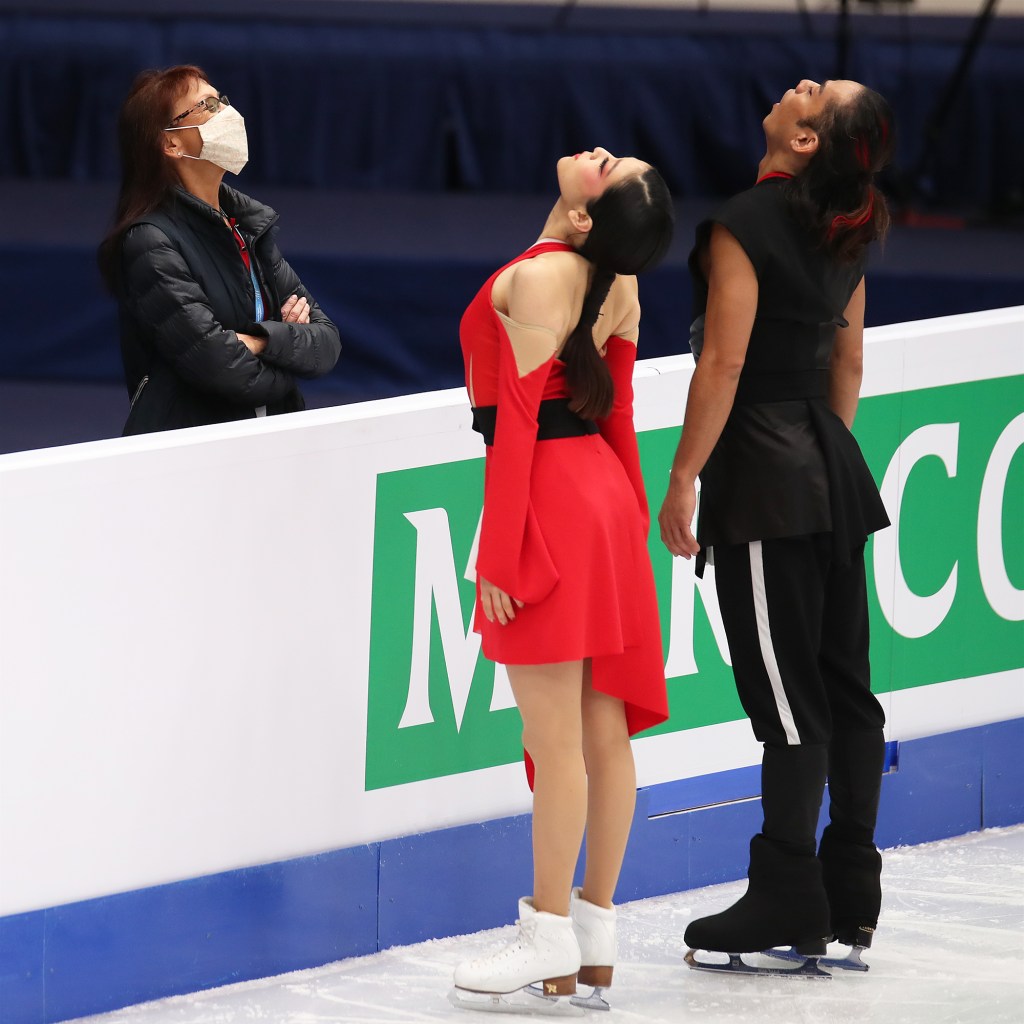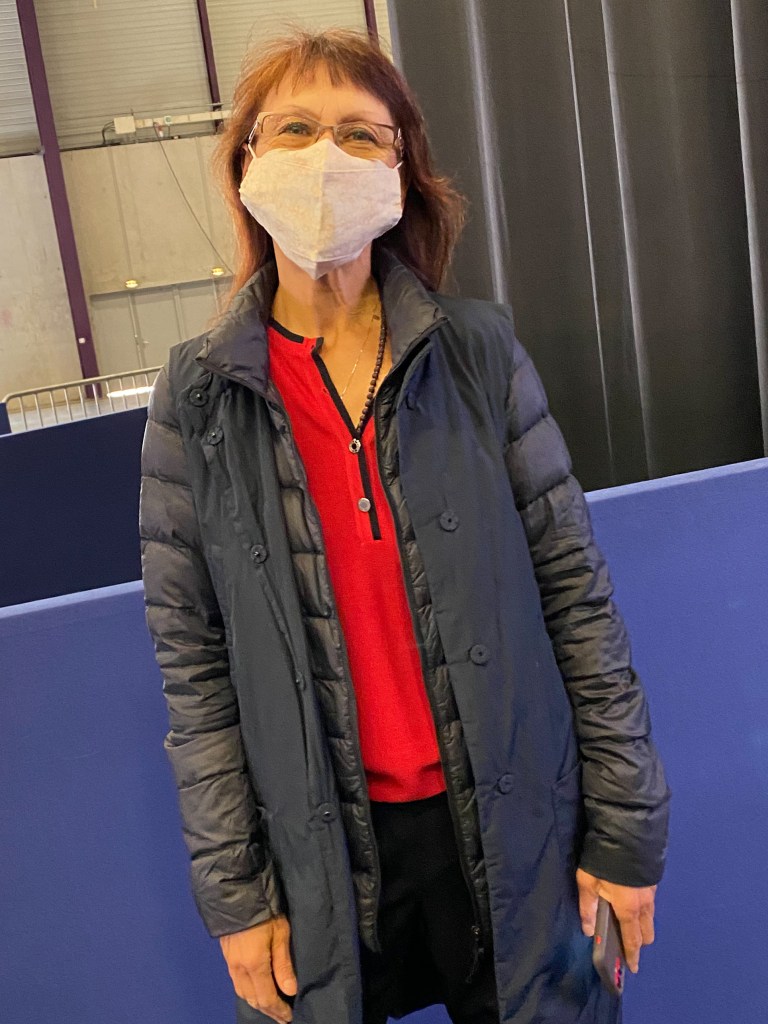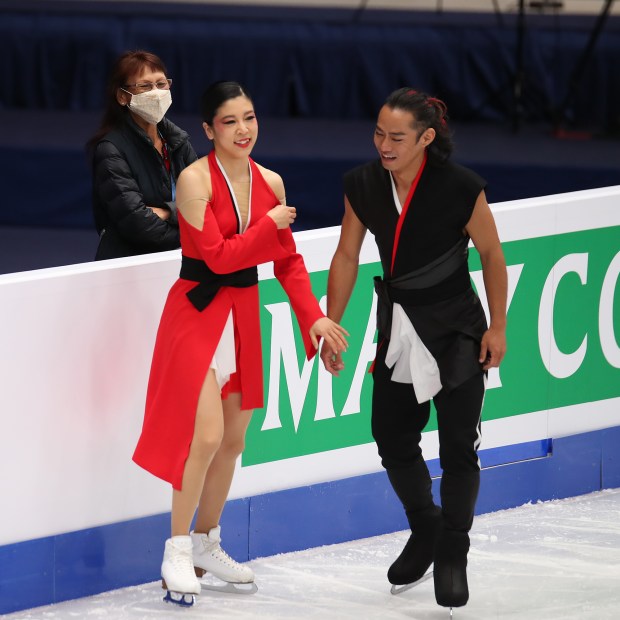By Hiro Yoshida
Marina Zoueva needs no introduction. Choreographer and coach to Olympic champions and medallists, this is the third season which will see her guide one of Japan’s most iconic singles skaters on a new path in ice dance.
After almost three decades based in Michigan, Zoueva moved her International Skating Academy school south to Florida in 2019. Later that year she received a request from former student Kana Muramoto to work together again with a new partner who turned out to be 2010 Olympic bronze medallist and World champion Daisuke Takahashi. Zoueva was as stunned as the rest of the skating world when she eventually found out who it was she would be coaching, but she immediately saw the team’s potential.
“It was a surprise as well for me and I was extremely happy because I can see him right away as a wonderful dancer,” she said. “I knew he will fit perfectly in this discipline.”
Zoueva had been a keen observer of Takahashi’s career as a singles skater for many years.
“I remember when he was training in Hackensack (New Jersey),” she recalled. “He was very young and very tiny, but extremely emotional. If you see Daisuke skate once, you will never forget it. You will always remember the energy, expressions, and personality.
“He is one of my favourite skaters no matter in singles or even now ice dance. I always enjoy his natural beauty on ice.”
Although it was an unexpected transition, Takahashi has previously been on record stating his admiration for American ice dancers Meryl Davis and Charlie White who Zoueva successfully coached to Olympic gold in 2014. Drawing on her experience with White, Zoueva saw the potential of what might be possible for Takahashi.
“Charlie was a single skater and competed both at the same time,” she said. “He did Junior Grand Prix in singles and Junior Grand Prix in dance, and I did work with him in both. That’s how I know it’s actually possible to do that.
“It’s a big advantage if you are a good and strong single skater and also if you ice dance. It gives you a little bit more with regard to the details of skating, quality of edges and expression.”
After competing as a singles skater for the final time at the 2019 Japan Championships, Takahashi relocated with Muramoto to train with Zoueva in Florida. However, the move was short lived and the team returned to Japan soon after due to the outbreak of the Covid-19 pandemic.
“I worked every day with them, and a lift coach also worked every day with them online,” Zoueva said. “We did stroking exercises and choreography.”
Opportunities for Muramoto and Takahashi to compete in their first season together were curtailed due to the ongoing pandemic and they only appeared at two domestic Japanese competitions in 2020 – NHK Trophy and the Japan Championships. They finished second at both events. Zoueva viewed that initial season as a base to establish themselves for what was to follow.
“They couldn’t get level four for some lifts, for some elements, but we knew that,” she said. “We thought it would still be much better to compete and present the team and have experience and then next year edge up. That was the plan and one that worked very well. Everyone just loved them. I got many comments from judges and officials, and they asked me to keep the same free dance for next season.
“They understood how much better it will be when they will have more time skating together and are able to upgrade the levels of the elements.
“I was one hundred percent sure they will be a great and compatible team. I don’t know what they thought, but as a coach I was confident.”

For the 2021-2022 season, Zoueva decided to give Muramoto and Takahashi as much experience as she could of performing in a competitive environment. A competition simulation was arranged at the Hertz Arena in Estero, Florida where Zoueva’s academy is based and in early September 2021 they also participated in a local club competition.
Their very first international assignment as a team was NHK Trophy in Osaka, Japan where they finished sixth ahead of Japanese champions Misato Komatsubara and Tim Koleto.
“Emotionally I can say they did their best performance,” Zoueva said. “I think their motherland gives them energy.
“It was a big competition in the season, and they were ready. They looked happy and beautiful.”
After NHK Trophy, they travelled to Poland to compete at the Warsaw Cup where they took home a silver medal and a whole set of new ISU personal best scores.
However, the pandemic once again presented a new obstacle when Japan shut its borders to most non-Japanese people to combat the spread of the Omicron variant in early December 2021.
Muramoto and Takahashi had to travel back to Japan without Zoueva for the Japan Championships at their side.
“They had to go two weeks before nationals and coaches couldn’t get visas to Japan at this time,” Zoueva explained. “There were three weeks without a coach. That’s really extremely hard even for a team who skate a long time together.”
Disaster struck for Muramoto and Takahashi in the rhythm dance when they collided with each other and fell. They rallied in the free dance finishing ahead of Komatsubara and Koleto, but they had to settle for second place overall.
“It’s very unfortunate to make the mistake at the most important competition,” Zoueva said. “I was really sorry about the kids slipping, and they were alone. They had coaches with them, but the expertise in ice dance is completely different than singles. You need special expertise.
“Qualification for Olympics makes you more nervous, definitely more excited. That cost them, but they did a good free dance.”
With only one spot in ice dance available for a Japanese team, the Japan Skating Federation set down four criteria in making their selection for the Beijing Olympics – the ISU World Standings, the ISU Season World Ranking, the ISU Season Best total score and the result of the Japan Championships. Muramoto and Takahashi were ahead on the Season World Ranking and Season Best total score, but Komatsubara and Koleto had the edge on the remaining two criteria. In the end, Komatsubara and Koleto were selected for Beijing. However, Zoueva strongly disagreed with the inclusion of World Standings in the selection criteria as Muramoto and Takahashi were a new team who had not had the opportunity to compete internationally in the previous season due to competitions being cancelled because of the pandemic.
“I talked to journalists, I talked to their agents, I talked to the Federation, and I explained to them about making the right decision about who would go to the Olympics,” Zoueva said. “For Kana and Daisuke, it didn’t make any sense to use World Standings because they are a new team.”
While they missed out on the Olympics, Muramoto and Takahashi were selected for the Four Continents and World Championships. At the Four Continents in Tallinn, Estonia, they became the first ice dance team from Japan to win a silver medal.
“He had at the same competition in singles medals – gold, bronze and silver,” Zoueva said. “His first medal was 2006 and his ice dance medal was 2022. It’s amazing how long he competed as an amateur, his life as an athlete and not just to skate, but to continue to be on the podium.”

Their debut at the World Championships in Montpellier, France in March resulted in a sixteenth-place finish. While much of the focus has been on Takahashi’s move from singles skater to ice dancer, Zoueva feels that Muramoto was essential in assisting him achieve the crossover so successfully.
“She was a singles skater,” Zoueva said. “She remembers her transformation from singles to ice dance. She has experience with partners. She has lots of experience with competitions and Olympic Games and she actually got very good results. With Chris she made records for Japanese ice dance. With Daisuke she makes new records.”
In June 2022, Muramoto and Takahashi confirmed that they would continue competing for another season. Zoueva believes they still have room to improve.
“They start from a great position,” Zoueva said. “The skating skills of Daisuke and Kana individually are amazing. They just need more time. When they will feel more comfortable, they will go immediately to another level of performance because the base is very, very high.”
While recent skating fans might know Zoueva best as an ice dance coach, she first made her name as choreographer for the iconic Russian pair of Ekaterina Gordeeva and Sergei Grinkov having worked with them from the beginning of their partnership right up until Grinkov’s untimely death in 1995. At a tribute show called “Celebration of a Life” following his passing, Zoueva choreographed a routine for Gordeeva to “Symphony No.5” by Gustav Mahler.

“I even can’t say it was choreography,” Zoueva recalled. “It just comes from a broken heart.
“I started working with them when she was eleven and he was fourteen. Can you imagine? Their whole career. They were like my children really.”
More than a decade later, Zoueva revived the same piece of music using a different version for Tessa Virtue and Scott Moir’s 2010 Olympic winning free dance. She feels happy that she was able to transform painful memories associated with the music into something more joyous.
“I wished Katia a good life for herself and for her daughter and I always wanted her to finish her story,” Zoueva explained. “When Tessa and Scott came to me, they had the same kind of connection on ice as Katia and Sergey, even without a personal relationship. I was so happy when they grew enough that they can perform and I could just nicely finish Katia’s story.
“If you’re interested in music, you can listen to the version for Katia that I chose and for Tessa and Scott. It is the same piece of music, but a different sound. It’s more happy, more vivacious, that the future will be great. I choreographed that programme as a continuation of Katia’s tribute to make a new future. It was very special for me.”
Even after forty years of working with some of the most talented skaters in the world, it is clear that Zoueva is still passionate about her athletes.
“I love my skaters. If I can see the talent, I feel like I must do for them the best to show the best of them.”
A version of this article was published in Japanese in Volume 27 of Figure Skate Life magazine.
Make a one-time donation
If you enjoyed reading this article, please consider supporting our work!
Make a monthly donation
If you enjoyed reading this article, please consider supporting our work!
Make a yearly donation
If you enjoyed reading this article, please consider supporting our work!
Choose an amount
Or enter a custom amount
Your contribution is appreciated.
Your contribution is appreciated.
Your contribution is appreciated.
DonateDonate monthlyDonate yearly